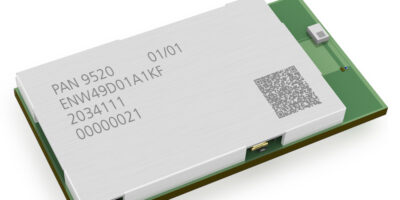Supporting the latest standards for secure networking, the PAN9520 2.4GHz 802.11b/g/n embedded Wi‑Fi module provides all the security features required for compliance with WPA2 and WPA3-Personal Wi-Fi security standards, says Panasonic Industry.
The PAN9520 is based on the Espressif ESP32-S2 microcontroller, which includes a high-performance 32-bit Xtensa LX7 CPU, a high sensitivity wireless radio, a baseband processor, boot loader and 320kbytes of SRAM. An encryption unit supports a range of security and encryption protocols, including CCMP, TKIP, WAPI, WEP, BIP, and AES.
It includes flash memory, a 40MHz crystal oscillator and a chip antenna. The integrated crystal is claimed to ensure connection performance over the entire temperature range and lifetime. Although believed to be one of the smallest modules on the market, it offers a rich set of peripherals, including full-speed USB OTG, SPI, UART, I²C.
The integrated module can be implemented quickly and easily into end-product designs – with or without a host controller, says the company. Panasonic Industry offers two variants with either 2Mbyte PSRAM and 4Mbyte flash or no PSRAM and 1Mbyte flash.
The module supports access point mode and station mode in parallel, allowing simultaneous Wi-Fi connections to smart devices and home network routers.
There is also the Espressif IoT integrated development framework (ESP-IDF), with which engineers can develop software for a range of applications, and access software examples which can be used to speed up development.
Panasonic develops technologies for wide-ranging applications in the consumer electronics, housing, automotive, and B2B sectors. The company celebrated its 100th anniversary in 2018 and operates 528 subsidiaries and 72 associated companies worldwide.
Panasonic Industry Europe is part of the global Panasonic Group and provides automotive and industrial products and services in Europe. It researches, develops, manufactures and supplies technologies and has a portfolio which covers key electronic components, devices and modules up to complete solutions and production equipment for manufacturing lines across a broad range of industries.







